NeoLucida - 21st Century Portable Camera-Lucid
NeoLucida is a 19th century optical drawing tool, updated for the 21st century.
Long before Google Glass ... there was a camera-lucid .
“Uh ... what?”
Camera Lucid.
This is a prism on a stick! To create realistic drawings!
Previously used everywhere.
Already whole generations do not know anything about it, the camera has not been produced for a long time.
And we returned it.
Really inexpensive.
For artists and students everywhere.
')
We developed the NeoLucida device. The first portable camera-lucida will be made again, almost a century later - and it will be the cheapest commercial camera ever made. We want to make this wonderful device available to young people, artists, architects, and anyone who loves to draw from life. But to be clear: our NeoLucida is not just a product, but a provocation. The purpose of making these modern cameras is to stimulate interest in media archeology - the history of visual culture and image processing technology that are closely intertwined.

Our project: NeoLucida - camera-lucid for the 21st century. Shown here is a working prototype, a combination of industrial and artisanal details.

What is “NeoLucida”?
NeoLucida is an auxiliary drawing tool that allows you to copy what you see. Our device is the first portable, authentic camera-lucid that will be manufactured in the last century, but we like to think of it as disrupting the conventional wisdom about creating art and the history of art. Our design is lightweight (250 grams), strong, compact enough to fit in a bag, very well adjustable, absolutely not electronic, with a free hardware license. It is also the cheapest camera lucid ever produced. If you like to draw from life, or it is interesting for you to try it yourself, how the old masters could create such accurate and realistic drawings - then NeoLucida is for you.
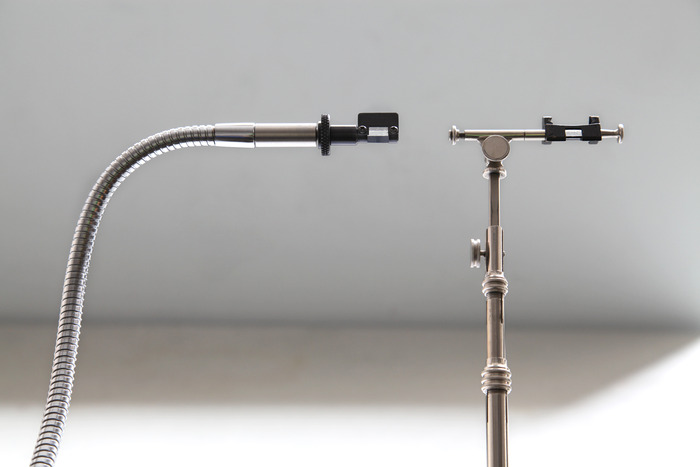
Left: Our NeoLucida, $ 40. Right: Antique Camera Lucida (19th century), about $ 350 on eBay. Thanks to modern innovation, such as the adjustable gooseneck, the NeoLucida has a much simpler design.
A bit of history.
From the beginning of the 17th century, artists usually use optical instruments to simplify the creation of realistic drawings. Lenses and mirrors were the “advanced technologies” of their time (and sometimes a trade secret) to create realistic images. In 1807, Sir William Hyde Wollaston invented the camera-lucida and raised the painting to a whole new level. Wollaston's device was simple: a prism on an adjustable stand. When an artist looks through a prism, he sees in front of him on the page a drawn object and his hand, joined in a perfect overlay.
In short, the camera-lucida allows you to copy what you see. And it allows you to do this in daylight, and there is no need for a dark box like a camera obscura. This is the magic of camera-lucida: it is portable, easy to use, and (with a little practice) you can easily and confidently copy the world around you to your page.
By the middle of the 18th century, similar devices were used everywhere. Indeed, the device proved so effective in creating accurate drawings that, according to Hocky-Falco’s controversial hypothesis , it is now believed that many of the most revered 19th-century drawings, such as the neoclassical portraits of the artist Jean-Auguste-Dominique Ingres, could be made only with the camera-lucida. It becomes surprisingly clear if you try to use such a camera - an experience that we hope to share with as many people as possible with the help of Kickstarter.
(If you want to learn more about how (possibly) old masters used optical technologies to create their work - look for David Hockney’s Secret Knowledge, or a BBC documentary film about his research.)
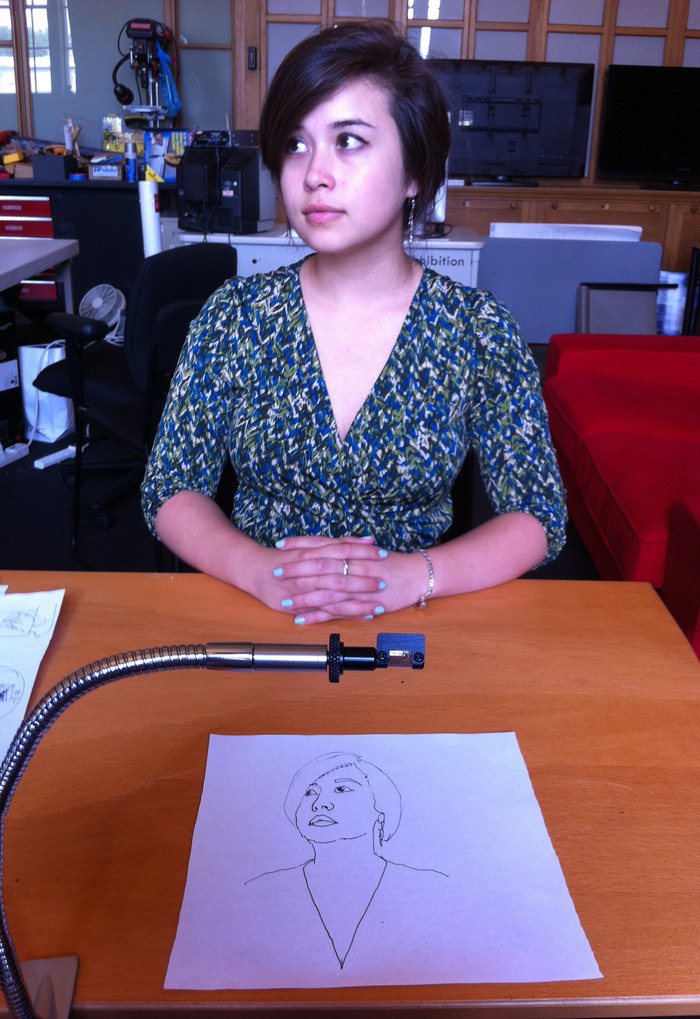
Installing NeoLucida: Attach NeoLucida with a clip to a table or drawing board. Place the object to be drawn in front of you and a piece of paper on the table under the prism. And now just look at the prism and draw.
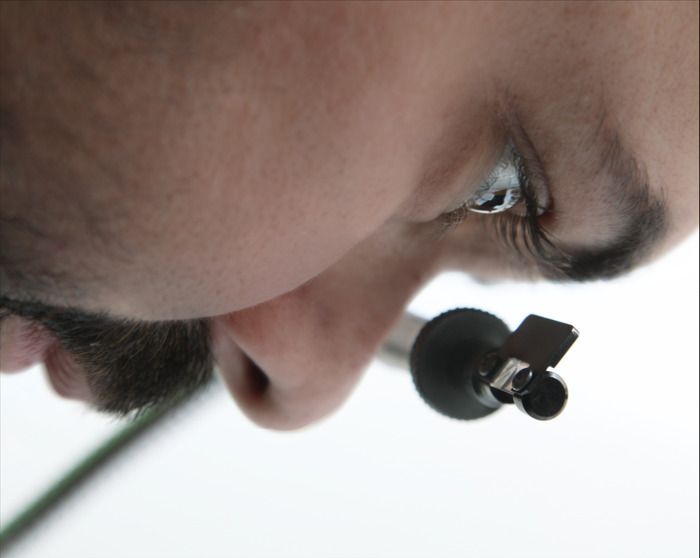
Bring your eye straight to the prism, look down at the protruding edge of the prism, and in front of you you will see the perfect combination of hand and scene.
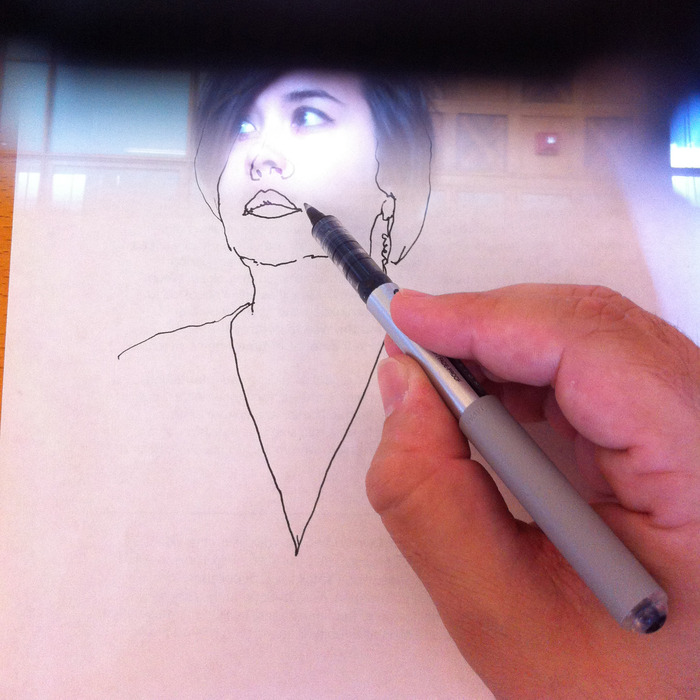
Our prototype is in action. This photo was taken through the NeoLucida eyepiece. The world before you is superimposed on the paper. Just copy what you see!
Now try the next experiment. Go to the group of students studying fine arts. Find those who claim to adore the “Old Masters” and ask them if they have ever used a camera-lucida (or at least have heard of it). Surely not (or they mix it up with a camera obscura). Perhaps the reason for this is another “camera” - a film camera - which revolutionized the creation of images in the last century. As soon as the photo became publicly available, the usual camera-lucid tool was almost completely forgotten. And the Old Masters began to attribute the possession of supernatural drawing abilities.
Portable camera-lucida became so rare and expensive that most students will never have the chance to try them in business, even in art schools they will not succeed. Authentic camera-lucida became a rarity and a fetish object for antique dealers and specialists, and now they usually cost $ 300 - $ 500 on eBay. But this surprisingly simple, useful device should not be so exotic!
So why are you doing this? We both have many students who believed that the most important thing is the ability to draw photorealistically. We both love realistic graphics, but not necessarily in the way they are usually taught - often ignoring the closely intertwined relationship between the drawing and the visualization technology. In particular, students-artists are invited to paint photo-realistic, in the manner of old masters, but without the proper tools for this. Therefore, our production of NeoLucida is a provocation, and not as a business. We want to start a discussion. We hope that NeoLucida will prompt new questions about the connection between art and technology, and perhaps even destroy the usual way of doing things in classrooms. Most importantly, we sincerely believe that with the help of camera-lucida, it is possible to change radically the way people see, how they paint, and how they think about art.

Portraits of Pablo, created with the help of a vintage camera-lucida (19th century, left) and NeoLucida (right).
Our Plan.
Wait, are there no modern, competitive products yet?
We would not do this if modern lucida cameras already existed that would meet our criteria, namely, ease of transportation, low cost, genuine optical design. Unfortunately, this is not the case. For example, LUCID-Art costs $ 200, weighs four times more than NeoLucida and does not fit in a small bag. In addition, LUCI costs twice as much as ours; it is cumbersome and difficult to tune. In addition, LUCI uses a mirror instead of a prism, and you have to draw an inverted image! (There is no such problem in our device, you can draw as you see, the image will not be inverted.) Surprisingly, LUCI is the only camera camera-lucid currently being produced without an elegant and compact optical design that has been used throughout 19th century.
Design and production.
We know that for a young artist who wants to experiment with this device, the price is important. Therefore, we designed the NeoLucida so that it consisted almost entirely of prefabricated parts made in China (for example, clamping, prism and adjustable flexible gooseneck) and that these parts were available in “business-to-business” markets, such as Alibaba. The only custom part (optical holder) was developed by our friends at StandardRobot (mechatronics studio in Pittsburgh) and will be made right here in the USA. We have already received several offers from different suppliers (international and local) for the manufacture of component parts, and we have taken into account the cost of delivery in the price of the product.
Our design is ready. We have learned a lot about the Chinese market and the parts we need. We have made and tested several working prototypes and are ready to fulfill our dream that an inexpensive camera-lucida falls into the hands of many people. But in order to do this, we must fulfill the minimum order requirement from our suppliers (As a rule, depending on the component, at least 500 pieces.) If we can receive 500 orders, then our dream can become your reality! NeoLucidas will be assembled at Golan Studios in Pittsburgh, several students will help us in this.
This is a limited edition of Free Hardware.
Our first batch of NeoLucidas will be our only batch, because, as we have already explained, for us this is a funny hooligan trick, not a business. As soon as we finish distributing NeoLucida devices, we will publish our project, CAD files, and all data about our suppliers, with a Creative Commons and Open-Source Hardware (OSHW) license, so anyone can continue the project (including, perhaps, commercially). Our project and other production information will appear on NeoLucida.com , Instructables, Scribd and other related sites. We hope that there will be people who will inspire our idea and continue our initiative!
Who are we?
Pablo Garcia and Golan Levin are professors of the University of Art and new-media artists, who are united by a huge interest in the history and poetics of visualization technology.
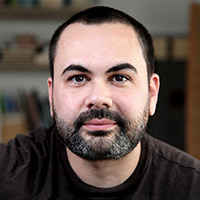
Pablo Garcia (@ prgarc ) Trained as an architect, Pablo's recent work has evolved from international artworks, provocations and research studies. His work has appeared on FastCompany / Co. Design, iO9, ArtInfo, ThisIsColossal, Gizmodo, Make, The Creators Project and many. Previously, Pablo has been taught by Carnegie Mellon, Parsons, University of Michigan, and Princeton. From 2004-2007, he also worked for Diller Scofidio + Renfro.

Golan Levin (@ golan ) Associate Professor of Computational Arts at Carnegie Mellon University; a member of the Free Art and Technology artist collective; and an enthusiastic Kickstarter supporter. At CMU, he also directs the Frank-Ratchye STUDIO for Creative Inquiry, a laboratory for anti-disciplinary research across the arts, sciences, technology, and culture. Golan has been called one of the “50” Designers Shaping the Future by Bruce Sterling, and a lot of other things.
A source
At the time of this writing, $ 386,443 out of the required $ 15,000 has already been raised.
I invested $ 40 + $ 25 for delivery, I hope to receive this device by autumn :)
Source: https://habr.com/ru/post/179345/
All Articles